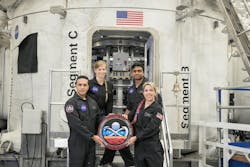Texas A&M to collaborate with NASA on commercial space opportunities
HOUSTON - The National Aeronautics and Space Administration (NASA) and the Texas A&M University System announced that the agency and educational institution will use underused land at the Johnson Space Center in Houston to build a facility for human spaceflight research and development that enables the commercial space economy.
The lease agreement will allow the A&M System and others to use NASA Johnson land to create facilities for a collaborative development environment that increases commercial access and enhances the United States' commercial competitiveness in the space and aerospace industries.
NASA's Johnson Space Center is home to the Mission Control Center for the agency's human space missions, astronaut training, human health and space medicine, and leadership of human spaceflight programs and missions. Exploration Park will play a role in helping the human spaceflight community attain U.S. goals for the commercialization and development of a robust space economy by creating an infrastructure that fosters a multi-use environment where academic researchers, aerospace companies, and entrepreneurs can collaborate with NASA and solve space exploration's challenges.
NASA announced proposals for the use of the undeveloped and underutilized land near Saturn Lane on 9 June 2023 and has just completed negotiations with the Texas A&M University System Board of Regents to formalize the lease agreement. The parcel is outside of Johnson's controlled access area and adjacent to its main campus. NASA will lease the land to the A&M System for an initial period of 20 years, with two additional 20-year options, for a potential total of 60 years.
In the coming years, NASA and its academic, commercial, and international partners will see the completion of the International Space Station Program, the commercial development of low Earth orbit, and the first human Artemis campaign missions establishing a sustainable human presence on the Moon in preparation for human missions to Mars.
Johnson is involved in the commercialization of space with commercial cargo and crew programs and private astronaut missions to the space station. The center also is supporting the development of commercial space stations in low Earth orbit, and lunar-capable commercial spacesuits and lunar landers that will be provided as services to both NASA and the private sector to accelerate human access to space.
